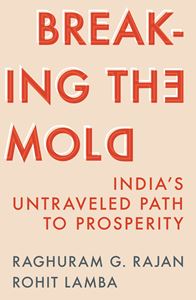
India’s Untraveled Path to Prosperity
Raghuram G. Rajan and Rohit Lamba
Princeton University Press
Princeton, NJ, 2024, 336 pp., $35
In their recent book Breaking the Mold: India’s Untraveled Path to Prosperity, Raghuram G. Rajan and Rohit Lamba argue that India’s future economic well-being lies in a different development strategy than the one successfully followed by many other advanced and emerging market economies—such as Japan, Korea, Taiwan Province of China, and, most notably, China.
These countries pursued a strategy of export-led manufacturing that leveraged cheap labor and transitioned into more sophisticated manufacturing as they became more integrated into global supply chains. Drawing on their extensive experience in policymaking in India, Rajan and Lamba argue that India should break this mold by instead focusing on services, an approach that is more aligned with India’s strengths and comparative advantage.
Why should India break the mold? The country has missed the bus, argue Rajan and Lamba, because the labor cost advantage no longer exists. And moving up the supply chain is not assured, as countries that moved early—not just China, but other emerging market economies, like Malaysia and Thailand—have developed their logistics so spectacularly that they can ship sophisticated manufacturing components easily and cheaply across the globe. Every segment of the manufacturing portion of global supply chains has become extremely competitive, so much so that even if India is successful in making its presence felt in low-skill assembly, it would not ensure profits or entry into other higher-skill manufacturing segments, they say.
Rajan and Lamba are persuasive in noting that it is in the early and late segments of a product’s production in the global supply chain—involving R&D, design, branding, marketing, and such—that the most value is added, with the manufacturing middle segment adding only a modest amount. They are not suggesting that India should discriminate against manufacturing, but caution against throwing costly subsidies at manufacturers.
Rajan and Lamba argue that India should instead leverage technology to boost exports of services, such as chip design and financial modeling, and those that cater to a growing domestic market, such as education and health care. But the strategy would require greater reform of, and investment in, India’s education system to generate a highly skilled, idea-generating, and entrepreneurial labor force. In their words, India must pivot from brawn to brain.
There is a lot to like in Rajan and Lamba’s book, including their call to revamp and revitalize India’s education and health care systems; improve data, governance, and transparency; and decentralize power to bring it closer to the country’s citizens. But their key recommendation leaves the reader wondering whether they are advocating a false binary choice between manufacturing and services. India does not have a sufficiently large skilled labor force to expand services as they advocate, and it will take a long time to get there.
It would also have been compelling if Rajan and Lamba had quantified the number of jobs that their proposed strategy would generate. With India projected to add 15 million people to the labor force every year, one could argue that it needs to create jobs across all possible activities and in every sector of the economy. To this end, wouldn’t it be better for India to pursue a wide swath of reforms—including improving the business environment, scaling up investment in education and health care, bridging infrastructure gaps, trade liberalization, and labor and land reforms—and leave the decision on where to invest, and which activities to pursue, to India’s entrepreneurial private sector?
Setting aside my disagreements, this book is a must-read for anyone who follows India. Rajan and Lamba should be applauded for lucidly articulating many innovative ideas that deserve serious attention and that should be actively debated.
Opinions expressed in articles and other materials are those of the authors; they do not necessarily reflect IMF policy.









